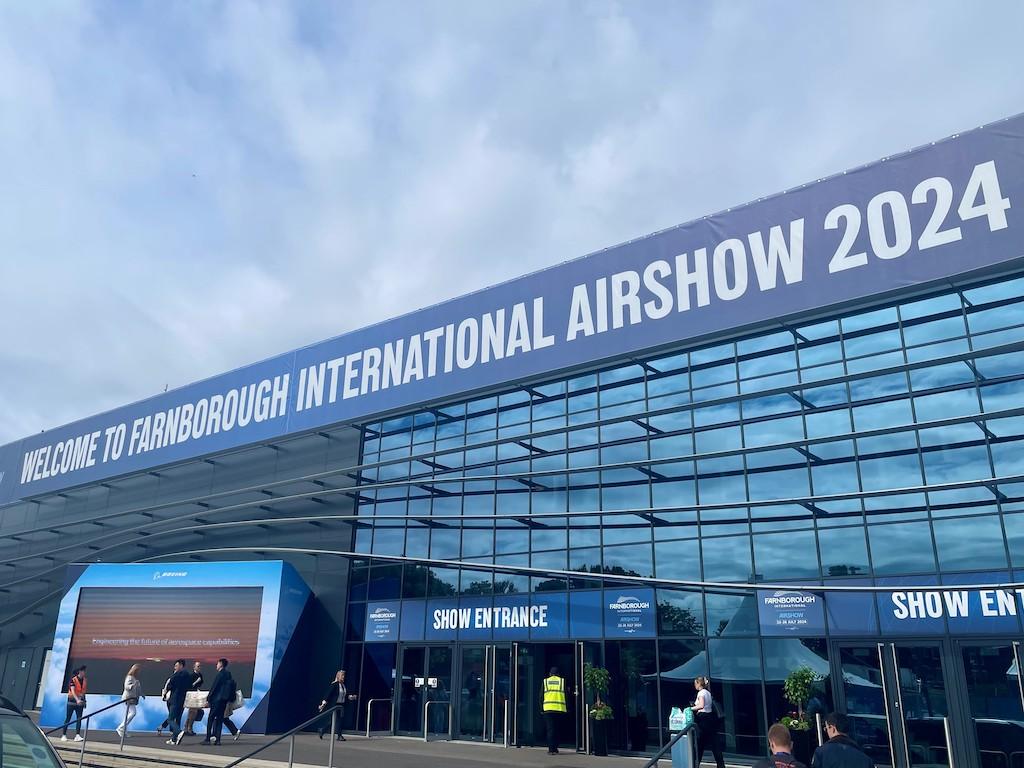
It’s only Wednesday, the third trade day of the 2024 Farnborough Airshow, but already it feels like a wrap. This was a show, not unexpectedly, that barely managed to squeeze out significant attendance and news on the third of four full trade days, at least on the commercial airline side of the industry. Our team of on-site and remote editors nonetheless found plenty to write about and post on the ATW On Location page of the Aviation Week site. Whether you were at the show or following news remotely, we hope you enjoyed all the coverage across ATW On Location, Aviation Week and the Aviation Week Show News.
Here are our takeaways from the show from a commercial airline industry perspective:
1. A Slow Show Low in Numbers
Farnborough 2024 was lacking in energy and numbers relative to past shows and even the last Paris Airshow, in June 2023. As of Wednesday, Farnborough organizers were posting that there had been 74,789 attendees, 1,262 exhibitors, 27 international pavilions and 250 civil, military and space delegations. By contrast, the 2023 Paris show recorded 210,000 trade visitors and 2,453 exhibitors. This Farnborough show was also noticeably low on airliners in the static and flying displays.
2. “New” Airline Orders Weren’t
More than ever, airline order announcements at this show generally weren’t new. Those that were “announced” at the show had previously been declared or were existing LoIs or MoUs that the airlines simply confirmed at Farnborough. Several airlines didn’t even attend the show to make their order/confirmation announcements; they simply issued the press release in the same week. And, like the show attendee numbers, the airliner order numbers were low: in the one- or two-digit margin versus the multiple hundreds that have been seen at previous Farnboroughs and continued at the Paris Airshow last year thanks to fast-growing airlines like India-based IndiGo. Airlines are still growing post pandemic; they’ve either long since stamped their claim on future narrowbodies and widebodies, and simply hope they show by the promised delivery time, or just didn’t see the need to travel to a field in southern England to seal a deal for a few more.
3. Boeing Wasn’t the Only Low-Key OEM Participant
Not surprisingly, given the major production and quality control issues Boeing Commercial Airplanes (BCA) is still working through under heightened FAA supervision, BCA declared before the show that its Farnborough presence would be low-key. It did not take a single Boeing-liveried airliner to the show. However, other manufacturers on the commercial side seemed to take this as their cue to keep their presence (and costs) down as well. Airbus did have new airliners in the static park but was far less showy than in its home country show at Paris. Regional airliner manufacturers and engine suppliers also had a subdued presence. They didn’t crow about Boeing’s situation—for one thing, too many of them still have their own supply chain and production problems to resolve—preferring to leave Boeing execs to explain themselves. But they were probably grateful for an opportunity unintentionally led by Boeing to tamp down their presence at a major airshow and save their time and money for other things, like delivering on order backlogs.
4. Time for a European Airshow Re-think?
The Paris and Farnborough Airshows were canceled during the height of the COVID pandemic. While it helped that airlines, for the most part, were not ordering aircraft or even flying much in those times, the truth is that, at least on the commercial airliner side, those shows weren’t much missed when it came to doing business. When airlines were ready to do deals, they did them. The airshow gaps were opportunities to rethink and restructure the two major European shows after years of manufacturers complaining that there was no need for a show every year in Europe. But those opportunities were not taken: the Farnborough and Paris organizers are rivals, and neither will give up “their” show, so the annual Farnborough or Paris ritual continues. But even if Boeing hadn’t dampened expectations for Farnborough, this show demonstrated something that may be inevitable for the future. Such shows, at least on the commercial airliner side, need to be shorter, easier to get to (Farnborough had major rail transport problems on the first trade day) and more mindful of the commercial decarbonization pressures, which will only grow. Showing off at an airshow doesn’t help an airline’s carbon net-zero credentials. Airline executives also don’t have the time or money to spend days at an air show (British Airways and Virgin Atlantic were among the few big airline exec names to attend Farnborough, which was a relatively short drive from their London Heathrow headquarters). Two, maybe three trade days would likely cover it and bring Farnborough and Paris in line with the two other major air shows in Dubai and Singapore that are more regionally focused in terms of airlines and suppliers. Chinese OEM COMAC went big at Singapore earlier this year but had an even lower presence than Boeing at Farnborough. Airshows, even Farnborough, have a role in this industry. But they may need to re-imagine that role.





